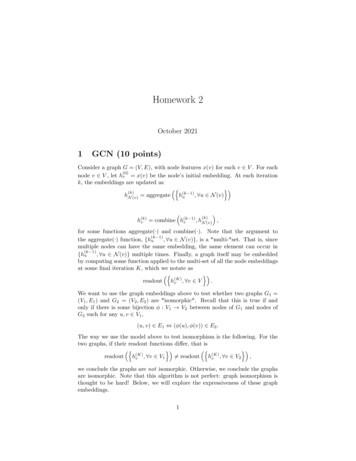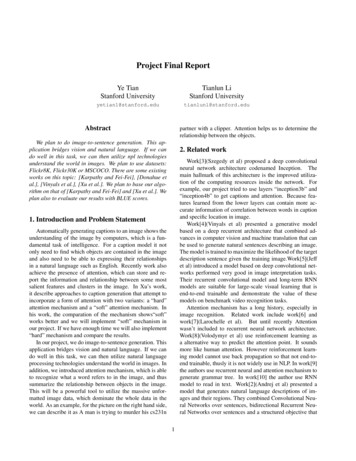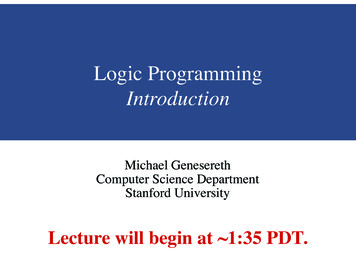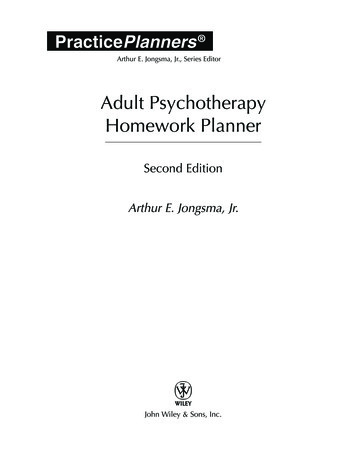
Transcription
Homework 2October 20211GCN (10 points)Consider a graph G (V, E), with node features x(v) for each v V . For each(0)node v V , let hv x(v) be the node’s initial embedding. At each iterationk, the embeddings are updated as no (k)hN (v) aggregate h(k 1), u N(v)u (k)(k 1)h(k), hN (v) ,v combine hvfor some functions aggregate(·) and combine(·). Note that the argument to(k 1), u N (v)}, is a *multi-*set. That is, sincethe aggregate(·) function, {humultiple nodes can have the same embedding, the same element can occur in(k 1), u N (v)} multiple times. Finally, a graph itself may be embedded{huby computing some function applied to the multi-set of all the node embeddingsat some final iteration K, which we notate as no readout h(K).v , v VWe want to use the graph embeddings above to test whether two graphs G1 (V1 , E1 ) and G2 (V2 , E2 ) are *isomorphic*. Recall that this is true if andonly if there is some bijection φ : V1 V2 between nodes of G1 and nodes ofG2 such for any u, v V1 ,(u, v) E1 (φ(u), φ(v)) E2 .The way we use the model above to test isomorphism is the following. For thetwo graphs, if their readout functions differ, that is no no readout h(K)6 readout hv(K) , v V2 ,v , v V1we conclude the graphs are not isomorphic. Otherwise, we conclude the graphsare isomorphic. Note that this algorithm is not perfect: graph isomorphism isthought to be hard! Below, we will explore the expressiveness of these graphembeddings.1
1.1Question 1.1 (1 point)Are the following two graphs isomorphic? If so, demonstrate an isomorphismbetween the sets of vertices. To demonstrate an isomorphism between twographs, you need to find a 1-to-1 correspondence between their nodes and edges.If these two graphs are not isomorphic, prove it by finding a structure (nodeand/or edge) in one graph which is not present in the other.1.2Question 1.2 (3 points)The choice of the aggregate(·) is important for the expressiveness of the modelabove. Three common choices are: n o (k 1)aggregatemax h(k 1) maxh(element-wise max), u N(v)uuu N (v)ii(1) X 1aggregatemeanh(k 1)u N (v) u N (v) no X (k 1)aggregatesum hu, u N (v) h(k 1)u no h(k 1), u N (v) u(2)(3)u N (v)Give an example of two graphs G1 (V1 , E1 ) and G2 (V2 , E2 ) and theirinitial node features, such that for two nodes v1 V1 and v2 V2 with the same(0)(0)(1)(1)initial features hv1 hv2 , the updated features hv1 and hv2 are equal if weuse mean and max aggregation, but different if we use sum aggregation.Hint: Your node features can be scalars rather than vectors, i.e. one dimensional node features instead of n-dimensional. Also, You are free to arbitrarilychoose the number of nodes (e.g. 3 nodes), their connections (i.e. edges betweennodes) in your example.1.3Question 1.3 (6 points)Our isomorphism-test algorithm is known to be at most as powerful as the wellknown *Weisfeiler-Lehman test* (WL test). At each iteration, this algorithm2
updates the representation of each node to be the set containing its previousrepresentation and the previous representations of all its neighbours. The fullalgorithm is below. Prove that our neural model is at most as powerful as theWL test. More precisely, let G1 and G2 be non-isomorphic, and suppose thattheir node embeddings are updated over K iterations with the same aggregate(·)and combine(·) functions. Show that if no no readout h(K)6 readout h(K),v , v V1v , v V2then the WL test also decides the graphs are not isomorphic.Hint: You can use proof by contradiction by first assuming that WeisfeilerLehman test cannot decide whether G1 and G2 are isomorphic at the end ofK’th iteration.2Node Embeddings with TransE (25 points)** What to submit: For Q2.1-2.2, Graph and corresponding useless embeddings which minimize the respective losses to 0. For Q2.3, Discussion ofbehavior of algorithm and resulting embeddings without normalization step.For Q2.4, Graph for which no perfect embedding exists, with justification. AndDiscussion on TransE embedding expressiveness.**While many real world systems are effectively modeled as graphs, graphs canbe a cumbersome format for certain downstream applications, such as machinelearning models. It is often useful to represent each node of a graph as a vector in a continuous low dimensional space. The goal is to preserve informationabout the structure of the graph in the vectors assigned to each node. Forinstance, the spectral embedding in Homework 1 preserved structure in thesense that nodes connected by an edge were usually close together in the (onedimensional) embedding x. Multi-relational graphs are graphs with multipletypes of edges. They are incredibly useful for representing structured information, as in knowledge graphs. There may be one node representing ”Washington,3
DC” and another representing ”United States”, and an edge between them withthe type ”Is capital of”. In order to create an embedding for this type of graph,we need to capture information about not just which edges exist, but what thetypes of those edges are. In this problem, we will explore a particular algorithmdesigned to learn node embeddings for multi-relational graphs. The algorithmwe will look at is **TransE**. We will first introduce some notation used in thepaper describing this algorithm. We’ll let a multi-relational graph G (E, S, L)consist of the set of *entities* E (i.e., nodes), a set of edges S, and a set of possible relationships L. The set S consists of triples (h, , t), where h E is the*head* or source-node, L is the relationship, and t E is the *tail* ordestination-node. As a node embedding, TransE tries to learn embeddings ofeach entity e E into Rk (*k*-dimensional vectors), which we will notate bye. The main innovation of TransE is that each relationship is also embeddedas a vector Rk , such that the difference between the embeddings of entitieslinked via the relationship is approximately . That is, if (h, , t) S, TransEtries to ensure that h t. Simultanesouly, TransE tries to make sure thath 6 t if the edge (h, , t) does not exist.**Note on notation**: we will use unbolded letters e, , etc. to denote theentities and relationships in the graph, and bold letters e, , etc., to denotetheir corresponding embeddings. TransE accomplishes this by minimizing thefollowing loss:XX[γ d(h , t) d(h0 , t0 )] )(1)L (0(h, ,t) S (h0 , ,t0 ) S(h, ,t)0Here (h0 , , t0 ) are ”corrupted” triplets, chosen from the set S(h, ,t)of corruptionsof (h, , t), which are all triples where either h or t (but not both) is replaced bya random entity.0S(h, ,t) {(h0 , , t) h0 E} {(h, , t0 ) t0 E}Additionally, γ 0 is a fixed scalar called the margin, the function d(·, ·)is the Euclidean distance, and [·] is the positive part function (defined asmax(0, ·)). Finally, **TransE** restricts all the entity embeddings to havelength 1: e 2 1 for every e E. For reference, here is the **TransE**algorithm, as described in the original paper on page 3:2.1Question 2.1 (3 points)Say we were intent on using a simpler loss function. Our objective functionincludes a term maximizing the distance between h0 and t0 . If we insteadsimplified the objective, and just tried to minimizeXLsimple d(h , t),(h, ,t) S4
we would obtain a useless embedding. Give an example of a simple graph andcorresponding embeddings that will minimize the new objective function all theway to zero, but still give a completely useless embedding.Hint: Your graph should be non-trivial, i.e., it should include at least two nodesand at least one edge. Assume the embeddings are in 2 dimensions, i.e., k 2.What happens if 0?2.2Question 2.2 (5 points)We are interested in understanding what the margin term γ accomplishes. Ifwe removed the margin term γ from our loss, and instead optimizedXX[d(h , t) d(h0 , t0 )] ,Lno margin 0(h, ,t) S (h0 , ,t0 ) S(h, ,t)it turns out that we would again obtain a useless embedding. Give an exampleof a simple graph and corresponding embeddings which will minimize the newobjective function all the way to zero, but still give a completely useless embedding. By useless, we mean that in your example, you cannot tell just fromthe embeddings whether two nodes are linked by a particular relation (Note:your graph should be non-trivial, i.e., it should include at least two nodes andat least one edge. Assume the embeddings are in 2 dimensions, i.e., k 2.)2.3Question 2.3 (7 points)Recall that TransE normalizes every entity embedding to have unit length (seeline 5 of the algorithm above). The quality of our embeddings would be muchworse if we did not have this step. To understand why, imagine running thealgorithm with line 5 omitted. What could the algorithm do to trivially minimizethe loss in this case? What would the embeddings it generates look like?5
2.4Question 2.4 (10 points)Give an example of a simple graph for which no perfect embedding exists, i.e.,no embedding perfectly satisfies u v for all (u, , v) S and u 6 v for(u, , v) / S, for any choice of entity embeddings (e for e E) and relationshipembeddings ( for L). Explain why this graph has no perfect embedding inthis system, and what that means about the expressiveness of TransE embeddings.Hint:By expressiveness of TransE embeddings, we want you to talk about whichtype of relationships TransE can/cannot model. As before, assume the embeddings are in 2 dimensions (k 2).3Expressive Power of Knowledge Graph Embeddings (10 points)TransE is a common method for learning representations of entities and relationsin a knowledge graph. Given a triplet (h, , t), where entities embedded as hand t are related by a relation embedded as , TransE trains entity and relationembeddings to make h close to t. There are some common patterns thatrelations form:* Symmetry: A is married to B, and B is married to A.* Inverse: A is teacher of B, and B is student of A.* Composition: A is son of B; C is sister of B, then C is aunt of A.3.1Question 3.1 (3 points)For each of the above relational patterns, can TransE model it perfectly, suchthat h t for all relations? Explain why or why not. Note that here 0embeddings for relation are undesirable since that means two entities related bythat relation are identical and not distinguishable.3.2Question 3.2 (3 points)Consider a new model, RotatE. Instead of training embeddings such that h t, we train embeddings such that h t. Here means rotation. You can thinkof h as a vector of dimension 2d, representing d 2D points. is a d-dimensionalvector specifying rotation angles. When applying , For all i 0 . . . d 1,(h2i , h2i 1 ) is rotated clockwise by i .Similar to TransE, the entity embeddings are also normalized to L2 norm 1.Can RotatE model the above 3 relation patterns perfectly? Why or why not?3.3Question 3.3 (4 points)Give an example of a graph that RotatE cannot model. Can TransE model thisgraph? Assume that relation embeddings cannot be 0 in either model.6
4Honor Code (0 points)(X) I have read and understood Stanford Honor Code before I submitted mywork.**Collaboration: Write down the names & SUNetIDs of students you collaborated with on Homework 2 (None if you didn’t).****Note: Read our website on our policy about collaboration!**7
The way we use the model above to test isomorphism is the following. For the two graphs, if their readout functions di er, that is readout n h(K) v;8v2V 1 o 6 readout n h(K) v;8v2V 2 o ; we conclude the graphs are not isomorphic. Otherwise, we conclude the graphs are isomorphic. Note that this algorithm is not perfect: graph isomorphism is .











